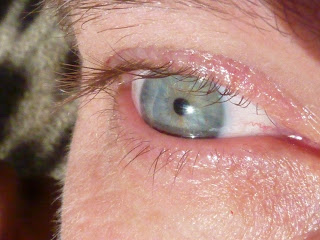
Here is part 4 of my 4 part series on nature's blues. Part 1 is here, part 2 is here and part 3 is here.
Gaining an understanding why something is the way it is in nature is not always a direct path. We know the blues found in nature are often the result of the object's internal structure rather than pigments, however the actual blue making process can vary. Although the blue of the sky and the blue of a feather can look like the same colour, the actual mechanism involved is very different. The two optical phenomenon involved in making these blues are Rayleigh scattering and coherent scattering. The blues produced either way can look the same.
So, which of these mechanisms is responsible for blue eyes? Rayleigh scattering is the culprit this time. Eyes appear blue when there are only small amounts of melanin present in the iris. Melanin is the pigment that makes the iris brown – a complete lack of melanin results in the pink eyes of an albino. When light passes into an minimally pigmented iris, tiny protein particles in the eye act just like the gas particles in the atmosphere blue wavelengths are preferentially scattered and the eyes appear blue.
As a tangent – here is how Leonardo da Vinci explained blue skies 200 years before Lord Rayleigh:
'I say that the blue which is seen in the atmosphere is not its own colour, but is caused by the heated moisture having evaporated into the most minute and imperceptible particles, which the beams of the solar rays attract and cause to seem luminous against the deep intense darkness of the region of fire that forms a covering among them.'
No comments:
Post a Comment